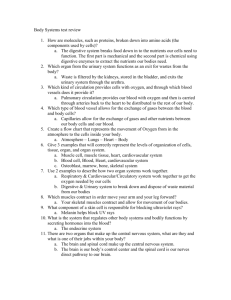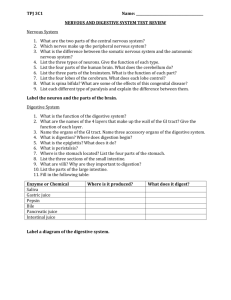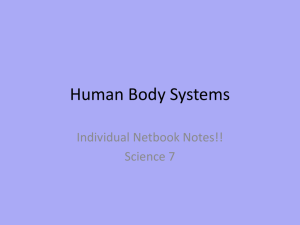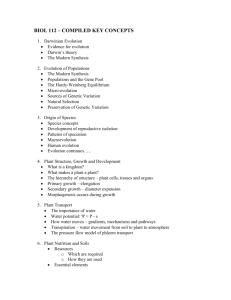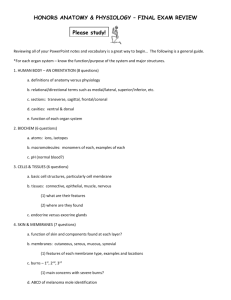Invert & Vert PPT
advertisement
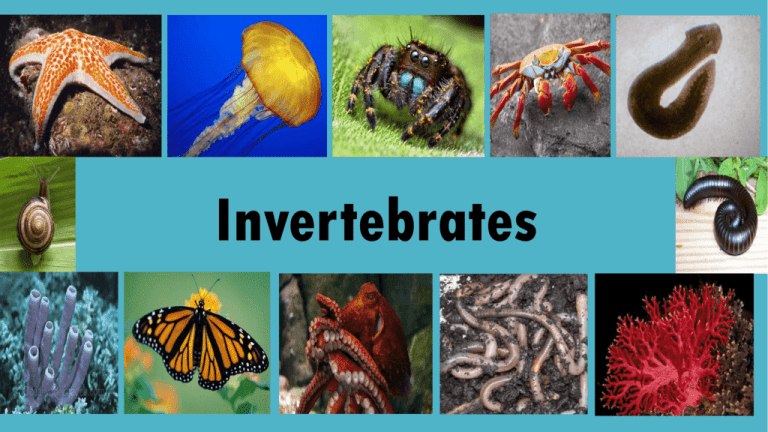
Invertebrates Porifera (Sponges) CIRCULATION: None RESPIRATION: None DIGESTIVE: Collar cells and amebocytes REPRODUCTION: Budding, Regeneration, Gremmules EXCRETION: None NERVOUS: None SKELETAL: Spicules MUSCULAR: None FEEDING: Filter feeder GROUPS: Demospongiae Calcarea Hexactinellida Cnidarians CIRCULATION: None RESPIRATION: None DIGESTIVE: Gastrovascular cavity REPRODUCTION: Budding, Regeneration, Production of sperm and eggs EXRECTION: None NERVOUS: Nerve net found in the mesoglea SKELETAL: None MUSCULAR: Muscle Cells FEEDING: Nematocyst penetrate prey and digestion happens in the gastrovascular cavity GROUPS: Hydrozoa (Jellyfish) Scyphozoa (Jellyfish) Cubozoa (Jellyfish) Anthazoa (Anemone) Polyp & Medusa Platyhelminthes CIRCULATION: None RESPIRATION: None DIGESTIVE: Mouth, pharynx and a gastrovascular cavity REPRODUCTION: Regeneration, Hermaphroditic EXCRETION: Flame cells & mouth NERVOUS: Ladder-like nervous system SKELETAL: None MUSCULAR: Muscle Cells FEEDING: Heterotrophic-eat dead or slow moving organisms. GROUPS: Turballarians (Nudibranch) Tremadotes (Tapeworm) Cestodes (Flatworm) Nematoda (Roundworms) CIRCULATION: None RESPIRATION: None DIGESTIVE: Mouth, intestine, anus REPRODUCTION: Separate sexes EXCRETION: Excretory tubules and excretory pore NERVOUS: Circular brain and several longitudinal nerve cords SKELETAL: None MUSCULAR: Longitudinal muscles FEEDING: Heterotroph, Parasitic (most are parasitic), Detritivore GROUPS: Trichinella (trichinosis-eating raw/uncooked pork or wild game) Hook worms Ascarid worms Pinworms Filarial worms Nematodes Annelida (Segmented Worms) CIRCULATION: Closed system Aortic arches Dorsal and ventral blood vessels RESPIRATION: Skin DIGESTIVE: Mouth, pharynx, esophagus, crop, gizzard (sac with hard particles that grind soil), intestine, anus REPRODUCTION: Hermaphroditic EXCRETION: Nephridia: 2 per segment NERVOUS: Ventral nerve cord with a small anterior brain SKELETAL: None MUSCULAR: Longitudinal and circular muscles FEEDING: Heterotrophic & Parasitic GROUPS: Earthworms Marine Annalids Leeches Mollusca CIRCULATION: Open System with a dorsal heart and sinuses RESPIRATION: Gills DIGESTIVE: Mouth, pharynx, esophagus, intestine, anus REPRODUCTION: Sexual EXCRETION: Nephridia NERVOUS: Brain and ventral nerve cord SKELETAL: Some contain shells MUSKULAR: Anterior and Posterior adductor muscles FEEDING: Herbivore (use radula), Carnivorous, & Filter Feeder GROUPS: Gastropods (Snails) Bivalves (Oyster, Clam, Mussel) Cephalopods (Octopus, Squid, Cuttlefish) Arthropoda CIRCULATION: Open system with a dorsal heart and sinuses RESPIRATION: Gills, Tracheal system, book lungs DIGESTIVE: Mouth, pharynx, esophagus, intestine, anus REPRODUCTION: Sexual: hermaphroditic, separate sexes, some parthenogenic EXCRETION: Malpighian tubules, green glands NERVOUS: Anterior brain and a ventral nerve cord SKELETAL: Exoskeleton made of chitin MUSCULAR: Complex muscular system FEEDING: Herbivores, Carnivores, Filter Feeders, Omnivores, or Parasitic GROUPS: Crustaceans (crab, lobster, shrimp) Spiders Ticks, Mites, Scorpions Horseshoe Crab Insects Metamorphosis Echinodermata Invertebrate Chordates Vertebrates Fish CIRCULATION: Single loop; twochambered heart RESPIRATION: Breathe with gills DIGESTIVE: Mouth, Esophagus, Stomach, Cecum, Gall Bladder, Liver, Pancreas, Intestine, Anus REPRODUCTION: Have either internal or external fertilization EXCRETION: Kidneys and cloaca NERVOUS: Developed brain & nervous system SKELETAL: Bone and/or Cartilage ECTOTHERMS EXT. COVERING: Scales EVOLUTIONARY DEVELOPMENT: Jaws & paired fins FEEDING: Herbivores, omnivores, parasites, filter feeders, detritivores MOVEMENT: Motile Many bony fish have a swim bladder that adjusts their buoyancy Have paired fins & lateral line system to detect movement & vibration GROUPS: Jawless fish: lampreys & hagfish Cartilaginous fish: (Chrondrichthyes) sharks, skates, rays Bony fish: (Osteichthyes) most fish species Amphibians CIRCULATION: Double loop; 3-chambered heart RESPIRATION: Gills to lungs DIGESTIVE: Mouth, Esophagus, Stomach, Small Intestine, Pancreas, Large Intestine, Cloaca REPRODUCTION: Rely on water for breeding & egg development Most go through metamorphosis EXCRETION: Kidneys and cloaca NERVOUS: Developed brain & nervous system. Nictitating membrane: protects eyes. Tympanic membrane: located on side of head; picks up vibration & sends to inner ear. SKELETAL: Bone ECTOTHERMS EXT. COVERING: Thin moist skin EVOLUTIONARY DEVELOPMENT: Ability to live out of water; Efficient movement; Lungs & breastbone (adults). FEEDING: Herbivores (tadpoles) & carnivores (adults). MOVEMENT: Motile; 4 legs, 2 legs, & legless GROUPS: Caudata – Newts & salamanders Anura – Frogs & toads. Apoda – Legless caecilians. Metamorphosis Reptiles CIRCULATION: Double-looped; 3chambered heart; except crocodiles, 4chambered heart RESPIRATION: All have lungs DIGESTIVE: Mouth, Esophagus, Stomach, Liver, Small Intestine, Pancreas, Large Intestine, Cloaca REPRODUCTION: Amniotic egg provides nourishment to embryo & protects it from drying out EXCRETION: Kidneys; water conserving excretory system NERVOUS: Developed brain & nervous system SKELETAL: Bone ECTOTHERMS EXT. COVERING: Dry, scaly skin & clawed toes EVOLUTIONARY DEVELOPMENT: Internal fertilization & lay eggs FEEDING: Herbivores, carnivores, & omnivores MOVEMENT: Motile; 4 legs somewhat under body (except snakes) GROUPS: Squamata: Lizards & snakes Crocodilians: Crocodiles Testudines: Turtles & tortoises Tuataras: Lizardlike Amniotic Egg BIRDS (AVES) CIRCULATION: Double-loop, 4-chambered heart RESPIRATION: Multiple air sacs DIGESTIVE: Beak, Esophagus, Crop, Stomach, Liver, Gizzard, Intestine, Pancreas, Cloaca REPRODUCTION: Lay amniotic eggs & incubate their eggs EXCRETION: Kidneys, similar to reptiles NERVOUS: Developed brain & nervous system SKELETAL: Hollow Bones ENDOTHERM EXT. COVERING: Feathers keep birds warm (down) & streamline them for flight (contour) EVOLUTIONARY DEVELOPMENT: Endothermy; Feathers FEEDING: Herbivore, Carnivore, Detritivores MOVEMENT: 2 legs for walking & perching; front limbs modified into wings Strong chest muscles GROUPS: Birds of prey: hawks, Song birds: canary; Flightless birds: ostriches; Aquatic birds: herons & pelicans; Parrots; Cavitynesting birds Mammals CIRCULATION: Double-looped; 4chambered heart RESPIRATION: Diaphragm beneath the lungs to help deliver O2 DIGESTIVE: Insectivore, Nonruminant herbivore, Ruminant Herbivore, & Carnivore REPRODUCTION: Internal fertilization; live births EXCRETION: Kidneys maintain homeostasis; cloaca no longer present NERVOUS: Developed brain & nervous system; some color vision SKELETAL: Bone and Cartilage ENDOTHERM EXT. COVERING: Most have fur or thick blubber for insulation EVOLUTIONARY DEVELOPMENT: Hair/fur; Mammary glands: feed young milk; Complex lower jaw; Distinctive limbs and backbone FEEDING: Mammals can be classified by the number & type of teeth MOVEMENT: Motile: 4 legs, 2 legs, some fly, some swim GROUPS: Monotremes: mammals that lay eggs; duck-billed platypus. Marsupial: mammals young complete 2nd state of development in a pouch; kangaroos & opossums. Placental mammals: Placental mammals carry their young inside the uterus until development is nearly complete. Young nourished through placenta Endotherm Ectotherm

